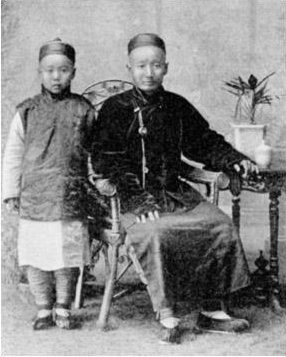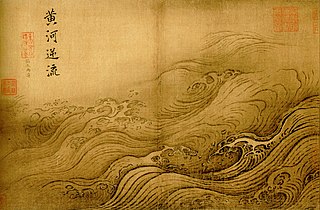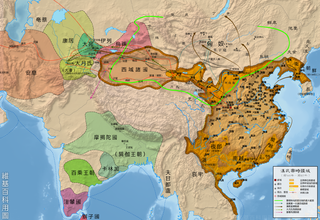Related Research Articles

The Uyghurs, alternatively spelled Uighurs, Uygurs or Uigurs, are a Turkic ethnic group originating from and culturally affiliated with the general region of Central Asia and East Asia. The Uyghurs are recognized as the titular nationality of the Xinjiang Uyghur Autonomous Region in Northwest China. They are one of China's 55 officially recognized ethnic minorities.

The Northern and Southern dynasties was a period of political division in the history of China that lasted from 420 to 589, following the tumultuous era of the Sixteen Kingdoms and the Eastern Jin dynasty. It is sometimes considered as the latter part of a longer period known as the Six Dynasties (220–589). The period featured civil war and political chaos, but was also a time of flourishing arts and culture, advancement in technology, and the spread of Mahayana Buddhism and Taoism. The period saw large-scale migration of Han people to lands south of the Yangtze. The period came to an end with the unification of China proper by Emperor Wen of the Sui dynasty.

The Xianbei were an ancient nomadic people that once resided in the eastern Eurasian steppes in what is today Mongolia, Inner Mongolia, and Northeastern China. The Xianbei were strongly suggested to be a multilingual, multi-ethnic confederation consisting of mainly Proto-Mongols, and, to a minor degree, Tungusic and Turkic peoples. They originated from the Donghu people who splintered into the Wuhuan and Xianbei when they were defeated by the Xiongnu at the end of the third century BC. Following the split, the Xianbei people did not have a direct contact with the Han dynasty, residing to the north of the Wuhuan. In the first century BC, the Xianbei began to actively engage in the struggle between the Han and Xiongnu, which culminated in the Xianbei replacing the Xiongnu on the Mongolian Plateau in 93 AD.

The Terracotta Army is a collection of terracotta sculptures depicting the armies of Qin Shi Huang, the first emperor of China. It is a form of funerary art buried with the emperor in 210–209 BCE with the purpose of protecting him in his afterlife.
The Manchus are a Tungusic East Asian ethnic group native to Manchuria in Northeast Asia. They are an officially recognized ethnic minority in China and the people from whom Manchuria derives its name. The Later Jin (1616–1636) and Qing (1636–1912) dynasties of China were established and ruled by the Manchus, who are descended from the Jurchen people who earlier established the Jin dynasty (1115–1234) in northern China. Manchus form the largest branch of the Tungusic peoples and are distributed throughout China, forming the fourth largest ethnic group in the country. They are found in 31 Chinese provincial regions. Among them, Liaoning has the largest population and Hebei, Heilongjiang, Jilin, Inner Mongolia and Beijing have over 100,000 Manchu residents. About half of the population live in Liaoning and one-fifth in Hebei. There are a number of Manchu autonomous counties in China, such as Xinbin, Xiuyan, Qinglong, Fengning, Yitong, Qingyuan, Weichang, Kuancheng, Benxi, Kuandian, Huanren, Fengcheng, Beizhen and over 300 Manchu towns and townships. Manchus are the largest minority group in China without an autonomous region.

Luoyang is a city located in the confluence area of the Luo River and the Yellow River in the west of Henan province, China. Governed as a prefecture-level city, it borders the provincial capital of Zhengzhou to the east, Pingdingshan to the southeast, Nanyang to the south, Sanmenxia to the west, Jiyuan to the north, and Jiaozuo to the northeast. As of December 31, 2018, Luoyang had a population of 6,888,500 inhabitants with 2,751,400 people living in the built-up area made of the city's five out of six urban districts and Yanshi District, now being conurbated. By the end of 2022, Luoyang Municipality had jurisdiction over 7 municipal districts, 7 counties and 1 development zone. The permanent population is 7.079 million.

The Yellow Emperor, also known as the Yellow Thearch or by his Chinese name Huangdi, is a mythical Chinese sovereign and culture hero included among the legendary Three Sovereigns and Five Emperors, and an individual deity (shen) or part of the Five Regions Highest Deities in Chinese folk religion. Calculated by Jesuit missionaries, who based their work on various Chinese chronicles, and later accepted by the twentieth-century promoters of a universal calendar starting with the Yellow Emperor, Huangdi's traditional reign dates begin in either 2698 or 2697 BC, and span one hundred years exactly.

The House of Aisin-Gioro is a Manchu clan that ruled the Later Jin dynasty (1616–1636), the Qing dynasty (1636–1912), and Manchukuo (1932–1945) in the history of China. Under the Ming dynasty, members of the Aisin Gioro clan served as chiefs of the Jianzhou Jurchens, one of the three major Jurchen tribes at this time. Qing bannermen passed through the gates of the Great Wall in 1644, and eventually conquered the short-lived Shun dynasty, Xi dynasty and Southern Ming dynasty. After gaining total control of China proper, the Qing dynasty later expanded into other adjacent regions, including Xinjiang, Tibet, Outer Mongolia, and Taiwan. The dynasty reached its zenith during the High Qing era and under the Qianlong Emperor, who reigned from 1735 to 1796. This reign was followed by a century of gradual decline.

Yu the Great or Yu the Engineer was a legendary king in ancient China who was credited with "the first successful state efforts at flood control", his establishment of the Xia dynasty, which inaugurated dynastic rule in China, and for his upright moral character. He figures prominently in the Chinese legend titled "Great Yu Controls the Waters". Yu and other sage-kings of ancient China were lauded for their virtues and morals by Confucius and other Chinese teachers. He is one of the few Chinese monarchs who is posthumously honored with the epithet "the Great".

The Yamato people or the Wajin is a term to describe the ethnic group that comprises over 98% of the population of Japan. Genetic and anthropometric studies have shown that the Yamato are predominantly descended from the Kofun and Yayoi, who migrated from mainland East Asia and Northeast Asia beginning during the first millennium BC via the Korean Peninsula, as well as a minority from the indigenous Jōmon that were already living on the Japanese archipelago for thousands of years prior.

Kaifeng Jews are a small community of descendants of Chinese Jews in Kaifeng, in the Henan province of China. In the early centuries of their settlement, they may have numbered around 2,500 people. Despite their isolation from the rest of the Jewish diaspora, their ancestors managed to practice Jewish traditions and customs for several centuries.

Huaxia is a historical concept representing the Chinese nation, and came from the self-awareness of a common cultural ancestry by the various confederations of pre-Qin ethnic ancestors of Han people.
Celestial Empire is an old name used to refer to China or the Chinese Empire, from a literary and poetic translation of the Chinese term, one of many names for China. The name was used in reference to the status of the Emperor of China as the Son of Heaven in the Sinosphere.

The First Era of Northern Domination refers to the period of Vietnamese history during which present-day northern Vietnam was under the rule of the Han dynasty and the Xin dynasty as Jiaozhi province and Jiaozhou province. It is considered the first of four periods of Chinese rule over Vietnam, and the first of the three in which were almost continuous and was referred to as Bắc thuộc.
Taiwanese people are the citizens and nationals of the Republic of China (ROC) and those who reside in an overseas diaspora from the entire Taiwan Area. The term also refers to natives or inhabitants of the island of Taiwan and its associated islands. The term generally applies to inhabitants on the island of Taiwan who share a common culture, ancestry and speak Mandarin, Hokkien, Hakka, or indigenous Taiwanese languages as a mother tongue. After the ROC government's retreat to Taiwan in 1949, the actual-controlled territories of the government were limited to the main island of Taiwan and Penghu, whose administration were transferred from Japan in 1945, along with a few outlying islands in Fujian Province which include Kinmen and Matsu Islands. Nowadays, Taiwanese people as a demonym may broadly refer to the indigenous peoples of Kinmen and Matsu as they share the same national identity with people of Taiwan. However, the islanders of Kinmen and the Matsu may not consider the "Taiwanese" label to be accurate as they were traditionally a part of Fujian and not Taiwan, maintaining a distinctive identity from that of the Taiwanese.

The Khitan people were a Turko-Mongol historical nomadic people from Northeast Asia who, from the 4th century, inhabited an area corresponding to parts of modern Mongolia, Northeast China and the Russian Far East.
During the late Zhou dynasty, the inhabitants of the Central Plains began to make a distinction between Hua and Yi, referred to by some historians as the Sino–barbarian dichotomy. They defined themselves as part of cultural and political region known as Huaxia, which they contrasted with the surrounding regions home to outsiders, conventionally known as the Four Barbarians. Although Yi is usually translated as "barbarian", other translations of this term in English include "foreigners", "ordinary others", "wild tribes" and "uncivilized tribes". The Hua–Yi distinction asserted Chinese superiority, but implied that outsiders could become Hua by adopting their culture and customs. The Hua–Yi distinction was not unique to China, but was also applied by various Vietnamese, Japanese, and Koreans regimes, all of whom considered themselves at one point in history to be legitimate successors to the Chinese civilization and the "Central State" in imitation of China.

Singaporeans are the citizens and nationals of the sovereign island city-state of Singapore. Singapore is home to a people of a variety of ethno-racial-religious origins, with the city-state itself being a multi-racial, multi-cultural, multi-religious, multi-denominational, multi-lingual, and multi-ethnic country. Singaporeans of Chinese, Malay, Indian and Eurasian descent have made up the overwhelming majority of the population since the 19th century. The Singaporean diaspora is also far-reaching worldwide.
The New Qing History is a historiographical school that gained prominence in the United States in the mid-1990s by offering a major revision of history of the Manchu-led Qing dynasty of China.

The Roman people was the body of Roman citizens (Latin: Rōmānī; Ancient Greek: Ῥωμαῖοι Rhōmaîoi) during the Roman Kingdom, the Roman Republic, and the Roman Empire. This concept underwent considerable changes throughout the long history of the Roman civilisation, as its borders expanded and contracted. Originally only including the Latins of Rome itself, Roman citizenship was extended to the rest of the Italic peoples by the 1st century BC and to nearly every subject of the Roman empire in late antiquity. At their peak, the Romans ruled large parts of Europe, the Near East, and North Africa through conquests made during the Roman Republic and the subsequent Roman Empire. Although defined primarily as a citizenship, "Roman-ness" has also and variously been described as a cultural identity, a nationality, or a multi-ethnicity that eventually encompassed a vast regional diversity.
References
- ↑ Hinsch, Bret (2004). "Myth and the Construction of Foreign Ethnic Identity in Early and Medieval China". Asian Ethnicity . 5 (1): 81–103. doi:10.1080/1463136032000168916.
- ↑ Su, Xiaowei (2017). "Researching the Image of the Yellow Emperor in China's Early Textual Sources and Archaeological Materials". Journal of Chinese Humanities. 3 (1): 48–71. doi:10.1163/23521341-12340043 . Retrieved 23 March 2024.
- ↑ Cook, Constance A.; Luo, Xinhui (2017). Birth in Ancient China: A Study of Metaphor and Cultural Identity in Pre-imperial China. State University of New York Press.